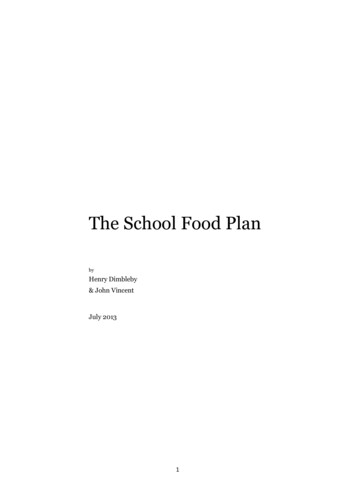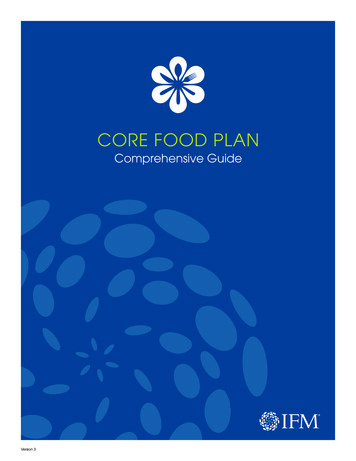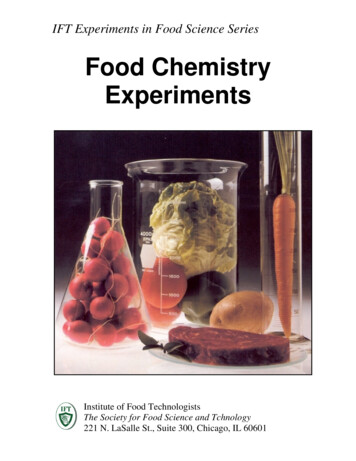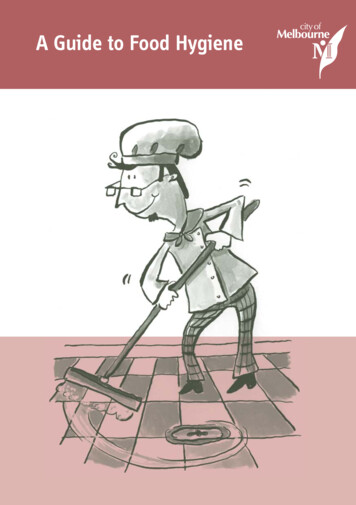
Transcription
The School Food PlanbyHenry Dimbleby& John VincentJuly 20131
2
Contents06 Summary14 Foreword28 Chapter One: Why it matters(In which we see the damage that is being done to the nation’s health, happiness and finances bybad diet, and lay out the benefits of introducing children to a good food culture as early aspossible.)32 Chapter Two: Teaching England to cook again(In which we explain how learning to cook and grow food can change lives, and rejoice athaving convinced the government to introduce compulsory cooking classes for all children.) .40 Chapter Three: Increasing take-up of school food: the means andthe end(In which we learn why so many children have swapped school dinners for packed lunches, andhow this has left some school canteens unable to break even; we consider the Herculeandifficulty of making a nutritionally-balanced packed lunch; and we demonstrate the win-winlogic of increasing take-up.)56 Chapter Four: What the schools that are doing itcommonright have in(In which we see how one school transformed its food service by listening carefully to what thechildren wanted; we learn that any kind of school (and any kind of caterer) can do this, as longas the head teacher leads the way; and we describe the three things that schools with great foodcultures have in common.)64 Chapter Five: Imaginative thinking(In which we see how individual schools have found ingenious ways around the problems theyface – such as drawing up contracts with caterers, cutting queues, or persuading children to eattheir veg – and we set about helping them to share their clever ideas.)74 Chapter Six: Supporting the heroic head teacher(In which we discover that the vast majority of head teachers believe that good food helpschildren perform better, but some heads feel daunted by the task of improving their school food;and we describe how they can get the support they need.)3
82 Chapter Seven: A workforce bigger than the Navy(In which we learn that the school food workforce has a range of skills that many in therestaurant trade would envy – but that it lacks status, confidence and sufficient training insome areas of practical cooking; we examine past attempts to tackle these issues; and wewelcome a new alliance committed to raising the sector’s game.)90 Chapter Eight: Getting regulation right(In which we find ourselves under a political storm cloud; we consider the complexities ofregulating school food; we conclude that it may be possible to create a simpler set ofregulations; and we set about doing so.)100 Chapter Nine: Small schools(In which we consider the particular finances of small schools, the importance of keeping theirkitchens open, and how we can support them.)112 Chapter Ten: Hunger and food poverty(In which we learn that there are children coming to school without eating breakfast, andothers who are skimping on lunch; and we welcome government funding to establish breakfastclubs in schools, and its promise to re-examine the criteria for free school meals entitlement.)120 Chapter Eleven: An assessment of universal free school meals(In which we learn why some countries – and some English councils – offer free school meals toall children; we consider the costs and benefits of this approach; and we recommend that thegovernment should introduce universal free school meals in all primary schools.)130 Chapter Twelve: What gets measured gets done(In which we outline how the government will measure success.)135 A checklist for head teachers138 AppendicesA.A brief history of school foodB.Approach to revising school food standardsC.Evidence on how school food affects health and achievement148 Acknowledgements4
Our Expert PanelProfessor Ashley Adamson – Public Health Nutrition (Newcastle University)Myles Bremner – Chief executive, Garden OrganicAnne Bull – National chair, LACALinda Cregan – Chief executive, Children’s Food TrustRichard Dunne – Head teacher, Ashley CE Primary SchoolLibby Grundy – Chief executive, Food for Life PartnershipJudy Hargadon – Former chief executive, Children’s Food TrustChristine Lewis – National officer for education, UNISONBrian Lightman – General secretary, Association of School and College LeadersCarmel McConnell – Chief executive, Magic BreakfastProfessor Theresa Marteau– Director, Behaviour and Health Unit, Cambridge UniversityTracy Mills – School cook, Shotton Hall AcademyDr Michael Nelson – Public Health Nutrition ResearchJeanette Orrey – Ex-school cook, co-founder Food for Life PartnershipSarah Owen – School cook, Stoke Newington SchoolLesley Powell – Principal, Shotton Hall AcademyMandy Snaith – Leeds City CouncilSara Jayne Stanes – Chief executive, Royal Academy of Culinary Arts, Chefs Adopt a SchoolStephanie Wood – School Food Matters5
SummaryIf you only have five minutes, read this.6
This plan is about good food and happiness. It is about thepleasures of growing, cooking and eating proper food. It is alsoabout improving the academic performance of our children and thehealth of our nation.What we foundThe quality of food in England’s schools has improved enormously since 2005, when JamieOliver alerted the nation to the horrors of the Turkey Twizzler. There has been a clear,measurable improvement in the nutritional quality of most school food, and a reduction injunk foods.The best schools do a brilliant job of weaving food education – cooking, growing vegetables,even modest efforts at animal husbandry – into school life and the curriculum. We have beenhugely impressed by the energy and enthusiasm we have witnessed among school cooks,caterers, teachers, nutritionists, parents, volunteers, charity workers and many others workingto make school food great.But there is still work to be done. Some schools are lagging behind, serving food that is muchtoo bland, boring and beige. Across the country, take-up of school food remains stubbornlylow, at 43%. That means that 57% of children are not eating school lunches at all. Some grazeinstead on snack foods served at mid-morning break (when the standard offerings in ourexperience are panini, pizza and cake). Others go off-site to buy their lunch – usually junkfood - or bring in a packed lunch.Many parents mistakenly imagine that a packed lunch is the healthiest option. In fact, it is fareasier to get the necessary nutrients into a cooked meal – even one of mediocre quality. Only1% of packed lunches meet the nutritional standards that currently apply to school food.This country faces a serious health crisis caused by bad diet. Almost 20% of children are obeseby the time they leave primary school at 11. Diet-related illnesses are putting a huge strain onthe nation’s coffers – costing the NHS 10 billion every year. We need to tackle the problemnow, before the costs (both personal and financial) become too heavy to bear.Eating school dinners is better for children. It is also better for the school’s finances. A halfempty dining hall – like a half-empty restaurant – is certain to lose money. In order for theschool food service to break even, average take-up needs to get above 50%. In other words, thesystem is currently bust. It has to be subsidised with money from school budgets and localcouncils, to the tune of 140 million a year.This state of affairs is neither desirable nor necessary. Parents currently spend almost 1billion a year on packed lunches; persuading just a fraction of them to switch to school foodwould make the system solvent again (and their children healthier).7
What needs to be doneWhat you have in your hands (or on your screen) is not a traditional ‘report’, or a set ofrecommendations to the government. It is a plan. It contains a series of actions, each of whichis the responsibility of a named person or organisation. These are the things that need tohappen to transform what children eat at school, and how they learn about food.Below, we have given a very condensed list of these actions. We heartily recommend that youread the whole plan to get a better sense of the purpose behind them. In the meantime, thereare a few essential points that need making.Increasing take-up is not something that can be done from the top-down. It requires a culturalchange within each school. It means cooking food that is both appetising and nutritious;making the dining hall a welcoming place; keeping queues down; getting the price right;allowing children to eat with their friends; getting them interested in cooking and growing.The only person with the power to orchestrate all this is the head teacher. They need supportfrom their governors and leadership team, but if the head isn’t behind changing the foodculture in a school, it won’t happen.The vast majority of head teachers already believe that good food is vital to children’s healthand academic achievement, and to the broader life of the school. But many feel they lack theknowledge and experience to improve their food culture. So this plan is aimed primarily atgiving head teachers the practical support, advice and information they need.We have put together a ‘checklist for head teachers’: a brief guide to the practical steps everyschool can take to improve the quality and take-up of its food. This includes everything fromchucking out prison-style trays and getting teachers to eat in the dining hall, to banningpacked lunches (it can be done!). The checklist can be found at the end of the plan.The government has agreed to provide funding for specialist organisations to go into 5,000schools that are struggling with their lunch service, to help them turn things around. BorisJohnson has also agreed to create flagship ‘food boroughs’ in London, with more areas tofollow if these are successful.Separately, we have set up a taskforce to help small schools overcome their particular logisticaldifficulties, and drawn up a strategy to improve the skills and morale of school caterers.Many studies have shown that hunger affects concentration, and that well-nourished childrenfare better at school. The government has agreed to allocate money to help schools in thepoorest areas establish breakfast clubs. And it has promised to look at extending free schoolmeal entitlement, to ensure that the children of the so-called ‘working poor’ do not go hungryat lunch.We have also recommended that free school meals should be extended to all primary schoolchildren, starting with the most deprived areas. This is the only one of our recommendationsthat the government has not agreed to yet. We understand that the considerable cost and theneed to involve other departments make it a big ask. But we are pleased that the Secretary ofState agrees with us in principle and we would urge schools and councils to consider fundinguniversal free school meals themselves.8
Providing a wholesome lunch for children is only half the battle. We also need to equip today’schildren with the skills they need to feed themselves – and, in time, their own children.We are delighted that the government has accepted our recommendation that cooking lessonsshould be made a part of the national curriculum for all children up to the age of 14. The newcurriculum will emphasise the importance of cooking nutritious, savoury dishes,understanding where food comes from, and taking pleasure in the creative arts of the kitchen.Finally, many people have been concerned by the government’s decision to exempt mostacademies and free schools from the existing school food standards. The fear is that, withoutlegal constraints on what they serve, these schools will be tempted to slide into bad habits. Wehave not found any evidence of widespread slippage – indeed, some of the best food we haveeaten has been in academies.However, we do believe it is wise to have some sort of safety net in place. To that end we haveworked with the Medical Research Council and our own expert panel to develop a set ofsimpler food standards, which we believe will be easier to implement and enforce. If the newstandards are agreed to be effective from a practical and nutritional standpoint, the Secretaryof State has agreed to make them mandatory across all types of school.In the past year, we have seen many different people from across the school food sector – andbeyond – coming together to help build on the good work that has been done already. MichaelGove, Sir Michael Wilshaw (head of Ofsted), the Department of Health, Public HealthEngland, Jamie Oliver, charitable organisations and representatives from all the major schoolfood providers – from private industry to local authority caterers – have agreed to do their bitto increase take-up and create a truly first class school food service.Good food provision in schools has been shown to lead not only to healthier children, but toimproved attainment. We hope this plan will help to create a generation of children who enjoyfood that makes them healthier, more successful and, most importantly, happier.Henry Dimbleby and John Vincent9
ActionsActions for head teachersHead teachers are the only people who can truly lead the revolution inschool food. We have provided a checklist for head teachers tohelp them start to turn round their food service – or nudge it fromgood to great. It can be found at the end of the School Food Plan.Actions for government1. Put cooking into the curriculum: make cooking and food anentitlement in key stages 1 to 3The Department for Education has incorporated this into the new nationalcurriculum, published on 8th July, 2013. See Chapter Two for details.2. Introduce food-based standards for all schoolsThe Department for Education will test and introduce a set of revised food basedstandards (built on a nutritional framework), with the intention of applying them tomaintained schools and all new academies and free schools by September 2014. SeeChapter Eight for details.3. Kick-start increased take-up of good school foodThe Department for Education will provide 11.8 million of seed funding over thenext two years – to enable independent experts to work with schools to increasetheir take-up and help them break-even. See Chapter Four for details.4. Set up financially self-sufficient breakfast clubsThe Department for Education will provide 3.15 million over the next two years toincrease healthy breakfast provision for children who are arriving at school hungry.See Chapter Ten for details.5. Set up flagship boroughs to demonstrate the impact ofimproving school food on a large scaleThe Department for Education and London Mayor’s Office will jointly fund andmanage two flagship boroughs. See Chapter Five for details.10
6. Investigate the case for extending free school mealsentitlementThe Department for Education will lead this, working with the rest of government. SeeChapter Ten for details.7. Train head teachers: include food and nutrition in headteacher trainingThe National College for Teaching and Leadership has agreed that content on food andnutrition should be included in their head teacher programme. See Chapter Six fordetails.8. Public Health England will promote policies which improvechildren’s diets in schoolsPublic Health England has agreed to promote interventions which improve food qualityin schools and tackle childhood obesity. See Chapter Six for details.9. Ofsted inspectors to consider behaviour and culture in thedining hall and the way a school promotes healthy lifestylesOfsted has agreed to amend its guidance for school inspectors. See Chapter Twelve fordetails.10. Measure success – set up and monitor five measures to testwhether the School Food Plan is workingThe Department for Education will collect this data. See Chapter Twelve for details.Actions for us and others11. Share ‘What Works Well’ on a new website, to enableschools to learn from each otherWe will oversee the development of the new website, hosted at www.schoolfoodplan.com.See Chapter Five for details.12. Improve the image of school foodWe want parents to realise that school lunches are better than they used to be – andmuch healthier for their children than the alternatives. Richard Reed, co-founder ofInnocent smoothies, and the branding expert Wally Olins have agreed to help devise astrategy for spreading the word. Jamie Oliver has agreed to help with this through hiswork in different media (TV, magazines and social media). See Chapter Three for details.13. Bring school cooks closer to the rest of the catering sectorWe will work with ‘Lunch’ and ‘Hotelympia’ to include school cooks in these high-profileindustry events. See Chapter Seven for details.11
14. Improve the skills of the workforceA public-private alliance led by LACA will develop a more structured approach totraining and qualifications for school caterers. See Chapter Seven for details.15. Small school taskforce – caterers, kitchen designers andmanufacturers to work together to provide good food forsmall schoolWe will lead this taskforce, working with Annabel Karmel, CEDA, LACA, Brakes andothers. See Chapter Nine for details.16. Ensure small schools are fairly fundedWe will write to local authorities personally to let them know what we think would be anappropriate amount to fund food services in small rural schools. See Chapter Nine fordetails.Recommendation for government17. The government should embark upon a phased roll out offree school meals for all primary school children, beginningwith the local authorities with the highest percentage ofchildren already eligible for free school mealsThis is the only recommendation in this plan that the government has not agreed toimplement immediately. We hope that, at the very least, the subject will be debatedfurther across government departments and by people working in the field. We wouldalso strongly encourage councils to follow the lead of Islington, Newham and Blackpoolcouncils and consider funding this themselves. See Chapter Eleven for details.12
13
Foreword14
The first thing we did when we were asked to put together this plan was to get on a train andvisit a school. Over the past year, we have been to – and eaten in – more than 60 schools allover England, and heard from hundreds more. We have spoken to children, teachers, parents,cooks, caterers, nutritionists, volunteers and charity workers, and industry bodies, many ofthem doing amazing work to improve the quality of school food. We have read the reports andpapers that have been written on various aspects of school food, commissioned our ownresearch, and taken a thorough look under the bonnet to understand the structure andeconomics of the service.The picture that has emerged is far more positive than we had expected. We have a school foodservice that feeds 3.1 million children a day 1 – equivalent to the population of Buenos Aires,and three times the number of children served in Finnish schools2, which are often held up asan example of global excellence.The food in most schools is miles better than it was eight years ago. There has been a steepreduction in junk foods3 and most of the dishes served at lunch are freshly cooked andnutritious – far more so than the average packed lunch. Most children really enjoy their schoollunches, too. In a survey we conducted with the Sunday Times, 77% of children described theirschool food as either tasty or very tasty.1 OC&C analysis based on findings in: Michael Nelson, Jo Nicholas, Katy Riley, Lesley Wood, Seventh Annual surveyof take-up and school food in England, School Food Trust, July 20122 According to the 2010 Census in inares/cuadro totalpais.asp), and Statistics Finland(http://www.stat.fi/tup/suoluk/suoluk vaesto en.html)3 For example, see Secondary Schools Food Survey 2011, School Food Trust, which found that meals eaten in 2011had nearly 50% more Vitamin A and at least 30% less fat, saturated fat, sodium and sugars compared with 2004.15
.Our briefOur brief was to answer two questions:1. How do we get our children eating well in school?a. What more needs to be done to make tasty, nutritious food available to all schoolchildren?b. How do we excite children about food so that they want to eat it?2.What role should cooking and food play more broadly in schools, to enrichchildren’s home lives and leave a legacy for later life?Our scope was limited to England. We were asked to consider primary andsecondary schools, but not special schools or early years.16
.What we have done Held over 100 meetings with experts, representative groups and organisationsworking with schools to improve their food culture Organised seven regional events around England, attended by nearly 500 peopleand representatives from over 150 schools Visited more than 60 schools to eat their food, attend lessons and discuss issueswith children, parents, cooks, teachers, business managers, teachers and heads Held 20 focus groups with children Convened an expert panel to develop the plan Commissioned primary research, such as a representative survey of 400 headteachers’ views on school food Analysed previously unseen data on what more than 15,000 children are actuallychoosing and eating for lunch Invited views from everyone and read over 1,500 letters and submissions fromschools and members of the public Worked with two national newspapers (The Sun and The Sunday Times) to runcampaigns which spread the good news about the improvements in school food,and encouraged feedback from children and parents Read research on school food from around the world Conducted detailed research and new quantitative and qualitative analysis on: Why it matters – links between good nutrition and academic performanceand healthWhat works well – in the UK and internationallyThe supply chain economicsEconomic analysis of individual schoolsWhat parents and children want Spoken at 17 events and conferences, and discussed school food issues with delegates.17
For the first time in four decades, take-up of school food is rising. It is now 43%overall—up by 7% in the past three years4 . This is despite the fact that parents oftenunderestimate its quality (bad memories of their own school dinners still linger).Progress is more marked in primary schools, although this is having a knock-on effect.Incredulous cooks told us of children arriving at secondary schools “actually askingfor vegetables”. There are still places where a lot remains to be done. At a secondaryschool in the North East we had lunch at a table of school prefects. The head boy waseating a breaded chicken cutlet in a white roll. The head girl had nothing but twoYorkshire puddings on her plate. When we talked to them about the benefits of abalanced diet – how the right kind of food could help them concentrate, boost theirsporting performance or improve their skin – you could practically see the light bulbsswitching on above their heads. These were clever children, but they had neverpreviously thought of food as anything but a means to preventing hunger (or as a‘treat’).We also found that the food served at mid-morning break is generally much lesswholesome than at lunch. This really matters, because many children eat their mainmeal of the day at this time, leaving their lunch break free for clubs and otheractivities. A typical mid-morning break menu might include pizza, panini, sausagerolls and cake – an almost entirely beige array of refined carbohydrates, laced withsugar and bad fats.But for every school that is lagging behind, we have seen an outstanding one.***Carshalton Boys Sports College, in Sutton, is not blessed with a great location. A largeaerial photo in the headmaster’s office shows the academy as a tiny rectangle in themiddle of a red brick estate that sprawls to the edge of the frame in every direction. Itis one of the largest estates in Europe. A massive 40% of the school’s children areeligible for free school meals.When Simon Barber took over the school ten years ago, only 4% of children managedto meet the academic benchmark of five GCSEs at A* to C grades including Englishand maths. The atmosphere and the discipline were terrible. School dinners weren’tjust bad: they were virtually non-existent. Children were actually locked out of themain school building for the duration of the lunch break, to give the teachers a breakfrom the mayhem.Simon’s genius was to realise that the canteen ought to be the centre of school life. Itwas the one place where the whole school could meet in an informal setting: whereteachers and children could sit down together to eat and talk, and in doing so cultivatea happier atmosphere. He understood the importance of table manners, not as asnobbish display of gentility, but as a means of teaching consideration, courtesy andsocial skills.4Latest figures for 2011-12 show average take-up in primary schools was 46.3% (an increase of 7 % ptsfrom 39.3% in 2008-09). In secondary schools it was 39.8% (an increase of 4% pts from 35% in 2008-09).Source: Michael Nelson, Jo Nicholas, Katy Riley, Lesley Wood, Seventh Annual survey of take-up andschool lunches in England, School Food Trust, July 201218
So having driven children from the dining hall for so long, how did Carshalton woothem back? The answer was to hire an experienced restaurant chef, Dave Holdsworth,and to compete directly with the local fast food outlets for the custom of olderchildren, while introducing a stay-on-site policy for younger ones. Dave makes properfood taste so good that children have flocked back to the canteen. From a low of 20%,take-up is now at 80%.But Carshalton hasn’t stopped there. It also offers a 1 breakfast for boys turning upearly and a free curry in the late afternoon for those staying late. In the classroom,cooking lessons are compulsory for all children up to the age of 14. They even run a‘lads and dads’ course where the boys teach their fathers to cook, to tackle the broaderproblems of malnourishment in the local area. They have chickens laying eggs and agarden club growing vegetables, all of which got used in the school kitchen.This is all part of Simon’s mission to nurture the whole child: alongside its amazingfood culture, the school excels in sport and drama as well as more academic subjects.Last year, 100% of its children got five GCSEs at A* to C grades, 60% includingEnglish and maths – putting Carshalton in the top 5% of most improved statesecondary schools.Simon is in no doubt about the connection between food and academic achievement.“For many of my boys, this lunch will be their main meal of the day. Good food makesthem happy, but also helps them work better,” he told us. “And the culture andbehaviour that begin in the canteen are responsible for an atmosphere that supportsattainment across the whole school.”Schools like Carshalton do not come about by government decree. They are driven bygreat leaders, and by cooks who are given the right circumstances in which to flourish.This is not to say that government intervention is pointless. We believe that the Blairgovernment was right to introduce compulsory food standards into schools. Whenthings are really bad you may need legislation to get to adequate. But we now need togo from adequate to good, and good to great.So how do we do this? All the research we have done points to two central insights.First, that increasing take-up of school food is both the means and the end. The morechildren there are paying for school dinners, the more money goes into the system –and the better it becomes. The quality of the food goes up, and the price comes down,making it affordable to more and more families: a virtuous circle.This may seem like an obvious point, but until quite recently school dinners weregenerally regarded as something that was done to schools by the local council, notsomething for which head teachers felt responsible. Changes in funding andlegislation mean that this is no longer the case.Creating a great food culture is not something that the state, councils, governors,parents or caterers can do without leadership from the head. This plan, therefore, isprimarily aimed at giving head teachers the inspiration and structural support theyneed to lead the way.19
“As a head teacher I always wanted to make sure that mychildren ate a good school lunch. Not only does a goodquality lunch improve a pupil’s concentration in theafternoon, but the atmosphere in the canteen is critical toencouraging good behaviour.More than that, lunch is the only time of day when the wholeschool – children and teachers – have a chance to cometogether. The atmosphere of the canteen sets a tone for therest of the school and helps to establish the school’s culture.Great schools do all things well. They not only nurture achild’s mind through outstanding teaching; they nurture thewhole child through sport, art and food. Only with acombination of all of these things will we enable ourchildren to reach their full potential.”Sir Michael Wilshaw,Chief Inspector of Schools20
“You won’t get good grades in schools unless you are happyand fulfilled and unless the whole child is looked after.That means making sure that children are well fed; makingsure they get a breakfast which can sustain them throughthe rigours of the morning; making sure that there is aproper lunch to look forward to; and making sure that aswell as having choice, children are eating food that ishealthy. The school lunch or dinner – the central meal ofthe day for many children – needs to be of the highestpossible quality.”Michael Gove,Secretary of State for Education21
In drawing up this plan, we resolved to follow certain principles. They were: PositivityWe were not going to spend our time criticising people. The sector had beencriticised enough – everyone feels quite bashed about – and there was an evidenthunger for a more posit
100 Chapter Nine: Small schools . instead on snack foods served at mid-morning break (when the standard offerings in our experience are panini, pizza and cake). . food - or bring in a packed lunch. Many parents mistakenly imagine that a packed lunch is the healthiest option. In fact, it is far easier to get the necessary nutrients into a .










